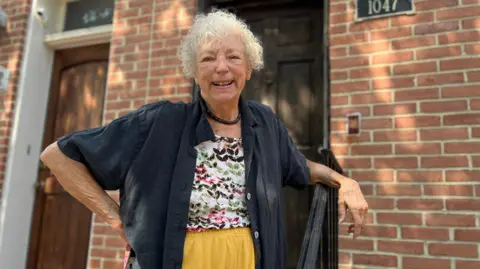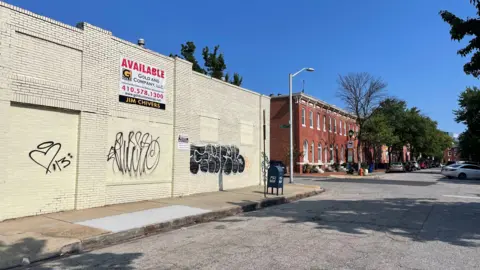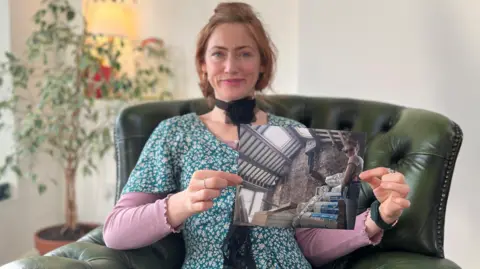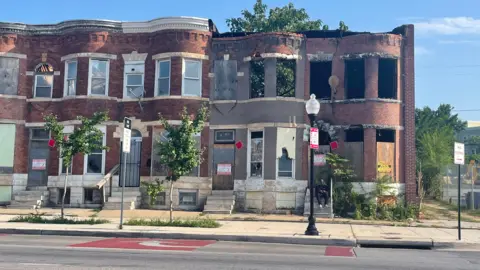 BBC
BBCIt was a regeneration idea that started half a century ago in the US, and has spread to other parts of the world.
But can selling off empty, derelict properties for a nominal amount help solve urban blight? And who are the winners and losers in such schemes?
Judy Aleksalza’s house in the Pigtown area of Baltimore feels like a real-life version of the Tardis, Doctor Who’s famous time-travelling police box. It seems bigger on the inside than the outside.
It’s part of a row of impeccably kept 19th Century terrace houses – there are freshly watered plant pots outside many of the front steps, and no litter or graffiti.
Ms Aleksalza bought the then abandoned property back in the 1976 for the same price as her neighbours – $1 (75p).
Since then she has spent tens of thousands of dollars, and much more in blood sweat and tears, transforming it. Poor weather, contractors who failed to do the work, it was, in Judy’s words – “a horror story”.
“I came very close to declaring personal bankruptcy,” she says. “It’s kind of like childbirth, you know. It was horrible while it was going on.
“But you know, after it was all over, I said ‘it is mine, it’s all mine’. And the stability of having your own home is everything.”
Baltimore, 40 miles (64km) northeast of Washington DC, was one of the first cities in the US to try what it called “urban homesteading”. Vacant properties were sold off for just one dollar, allowing people to get on the housing ladder who might not otherwise be able to afford it.
The scheme was run by Jay Brodie who at the time was a senior figure in the city’s housing department.
“We picked names out of a hat and started meeting with them,” he remembers. “Once it was finished, it made the cover of the American Express magazine… and we said ‘we have something here’.
“We’re talking about something that you can see and touch. They were living examples of what could be done with Baltimore row houses.”
The project came to a halt in 1988 after Mr Brodie left the department in the early 1980s. But some ideas never quite go away, and instead spread their wings.

Fast forward to 2013, and three and a half thousand miles away, another port city that had faced similar issues of urban decay decided to try something similar – Liverpool.
Tony Mousedale from Liverpool City Council’s housing department had heard about the idea of selling off abandoned properties cheaply. He suggested Liverpool try it.
So they offered properties in the Webster Triangle area of Wavertree for just £1.
“I think we just felt that there was an appetite for people who were keen to renovate derelict houses, starting from scratch, putting their own stamp on it,” says Mr Mousedale.
“We put that sort of concept out there, and received a very positive response. I think it really captured people’s imagination.”
It might have raised a lot of interest, but some of the more than 100 buyers were brought down to earth with a bump.
“There was a rat infestation, and I had a tree growing out of the front bay window frame,” says Maxine Sharples, one of those who bought into the scheme. “It was gruelling, backbreaking work. It was filthy.”
Despite all the heartache and hard work, Maxine Sharples says it was worth it. “It’s completely changed my life. I don’t take it for granted that I’m living in the home of my dreams that I renovated and got for a quid.”
Similar schemes have also introduced in other countries, including Italy, and Spain.
 Maxine Sharples
Maxine SharplesAnd things have in some ways come full circle. Earlier this year Baltimore unveiled new plans to help regenerate its blighted neighbourhoods.
Part of that? A scheme called the Fixed Pricing Program that would allow residents to buy a derelict property for just $1.
Any individual wishing to buy a house for a dollar needs to show that they have $90,000 for the renovation. Plus, they must already live in the city, and promise to reside in the renovated property for five years.
Interest in the project is said to be high. Alice Kennedy, the Baltimore Housing Commissioner, tells me: “I think that it definitely got people more excited or interested than even, I think, we recognized that would happen.”
Yet so far only a handful of people have met the criteria and actually been successful.
Meanwhile, non-profit providers of affordable housing, known as “community land trusts”, can also buy the Baltimore buildings for $1, while large housing developers can apply to purchase them for $3,000.
Such $1 home schemes are quick to make media headlines, but critics questions what they can achieve. One such sceptic is David Simon, the creator of the hit TV series The Wire, which was set in Baltimore.
The gritty show, which was broadcast from 2002 to 2008, was inspired by Mr Simon’s own experience as a reporter for the Baltimore Sun newspaper.
He says that the original Baltimore scheme didn’t benefit those who were economically marginalised, as the properties were bought by people who had enough money to do them up.
“I mean it brought tax base back to the city,” says Mr Simon, who still lives and works in Baltimore. “But it wasn’t socialistic in the sense that I don’t think it was successful in, in spreading the wealth. But I don’t think any urban renewal, or any urban reclamation, that I’m familiar with in the city, has ever been egalitarian.”

In Liverpool Tony Mousedale accepts that while its scheme has helped improve the area in question, there are still issues with anti-social behaviour, and there are still boarded up properties that haven’t been renovated, a decade later.
“I would say anti-social incidents are not as frequent as they used to be,” he says. “Generally speaking, the homes for a pound scheme has been a driver for regenerating the area. There is still a way to go. I think in some ways regeneration never finishes, does it? There’s always more to do.”
Back in Baltimore, David Lidz runs Waterbottle Cooperative, a grassroots organisation that buys up decaying properties in Baltimore and renovates them to rent to people on low incomes.
He is concerned that individuals buying homes for a $1 may lead to areas being gentrified, which results in general rent levels being “jacked up” and people on lower incomes being “pushed out”.
“So then you ask yourself where do those people go? Well they move over to the next rotting neighbourhood. That’s not good.”
At the Baltimore Housing Commissioner’s office, Alice Kennedy says she’s aware of the problems previous renewal schemes have created, and is keen to learn the lessons of the past.
“A top priority for all of us that work in the city is to redress the racist housing policies of the past and the socioeconomic segregation,” she says.
“For me, success is really knowing that our communities are going to be whole again, and that they’re going to have the ability to thrive from birth to death as a human in the city of Baltimore.”


